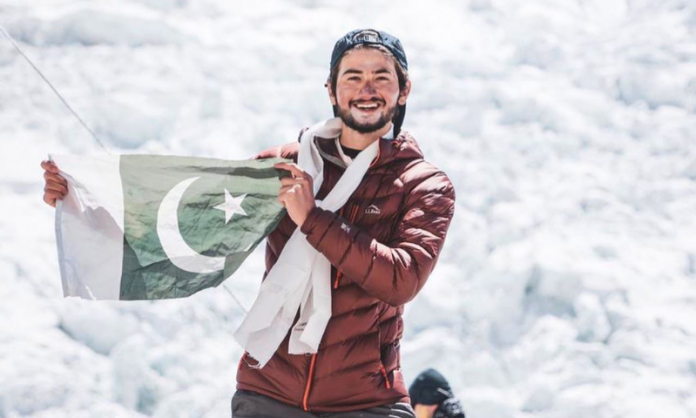Shehroze Kashif, 19, became the youngest Pakistani mountaineer to reach the summit of Mount Everest — 8,848.86 metres — on Tuesday.
In an update on Facebook, Nepalese mountaineer and the expedition manager of Seven Summit Treks, Chhang Dawa Sherpa, congratulated Kashif for becoming the youngest Pakistani to climb Mount Everest. “This morning Kashif successfully climbed the Mt. Everest as a part of Seven Summit Treks — Everest Expedition 2021,” he wrote.
An update on Kashif’s Facebook page said, “ALHAMDULILLAH ALHAMDULILLAH. Received the text confirmation from Shehroze Kashif. History has been made ! Ma Sha Allah Shehroze has summited Everest.”
Hailing from Lahore, Kashif is also the youngest Pakistani to have climbed Broad Peak (8,047m) at the age of 17. He used supplemental oxygen on his climbs to Broad Peak and Everest.
His expedition to Broad Peak earned him the title “The Broad Boy”.
Earlier, Samina Baig, the first Pakistani woman on Everest, was also the youngest Pakistani, at the age of 23, to reach the summit of the tallest 8,000er in the world.
Kashif’s interest in trekking developed at a young age after he accompanied his father on an outdoor trip.
In a TV interview, the young climber said that long before he reached his first summit, he was fascinated by the idea of what was at the top. “Whatever I had imagined was not there at the top. However, when I reached the top, I felt pride that I have achieved something,” he said.
Kashif spent well over a month acclimatising at the Everest base camp in Nepal while keeping his fans updated via social media.
In another TV interview in February, he spoke in detail about climbing, fitness, and the finances required for achieving big goals.
“There is no comparison between the training levels of a cricketer and a mountaineer. Sometimes, we have to climb for 26-hours in one go,” he said.
“The strongest thing in the world is the human mind, you cannot beat it. If your brain stops working at a higher altitude, that’s a big thing. You have to train yourself for those conditions,” Kashif went on to say while sharing his fitness routine and its importance in decision-making at heights. “Mountaineering doesn’t ask for compromise, mountaineering asks for sacrifice.”
Kashif went on to add that the Everest expedition cost him Rs10 million, with no sponsorship from the government or the private sector.
In the same interview, Kashif said that he wants to form a team with Sajid Sadpara — the youngest person in the world to summit K2 at the age of 20 — and climb all the 14 8,000m peaks. However, he quickly pointed out that this would require patronage and sponsorship for the young mountaineers. If the government can give 10m to each cricketer, it can do anything, he told the shocked anchor.
The Lahori teen’s first climb was at the age of 11 when he trekked to the 3,885m Makra Peak, followed by Musa Ka Musalla, a 4,080m peak.
Continuing to train for longer and harder treks, he did the Gondogor La K2 Base Camp trek at the age of 14 and at 15 was able to complete the Khurdo Pin Pass (5,800m) trek. At 18, he did Khusar Gang, a 6,050m peak Alpine style.
Confirming Kashif’s summit, Alpine Club of Pakistan secretary Karrar Haidri congratulated the young climber on this feat.
Talking to Dawn.com, Shehroze’s father called him a “special one”.
“He has been doing all these treks and climbs on his own. In fact, when he got to the Everest base camp, we found out how things could go wrong during the expedition,” said Kashif Abbas.
He shared that neither he nor his other three sons had any interest in trekking or mountaineering.
“On his first trek, I had asked the guide to take him to the top and from then onwards Shehroze went to all trips on his own.
“So far I have supported Shahroze and the response to his success is overwhelming. Probably after Mohammad Ali Sadpara, he is the most famous Pakistani climber,” the beaming father said.
Difference between ‘Alpine’ and ‘Expedition’ style
Nepal, China and Pakistan are home to the 14 highest peaks in the world, also known as the 8,000ers. While the world’s tallest mountain Everest (8,848m) is located in Nepal, Pakistan is home to five 8,000m peaks including K2, Gasherbrum 1 and 2, Broad Peak and Nanga Parbat.
Climbers enter the ‘death zone’ (above 8,000m the pressure of oxygen is insufficient to sustain human life for an extended time span) to reach the summit of these 8,000ers, with most relying on bottled oxygen — much to the annoyance of those against commercial expeditions on the high mountains.
In mountaineering, the Alpine approach means no supplementary oxygen, packing light, zero reliance on fixed ropes and high-altitude porters/Sherpas and moving fast. This makes a climb over 6,000m riskier as the altitude increases.
Opposed to Alpine, Expedition style (or “siege” style) relies on fixed ropes set along the climbing routes by Sherpas/HAPs and the use of bottled oxygen.
Pakistani mountaineer Nazir Sabir was the first Pakistani to climb Everest on May 17, 2000. Years later, Hasan Sadpara, Samina Baig, Abdul Jabbar Bhatti and Mirza Ali reached the top of the tallest 8,000m peak. So far, all Pakistani summits have been done with the use of supplemental oxygen.National Geographic








